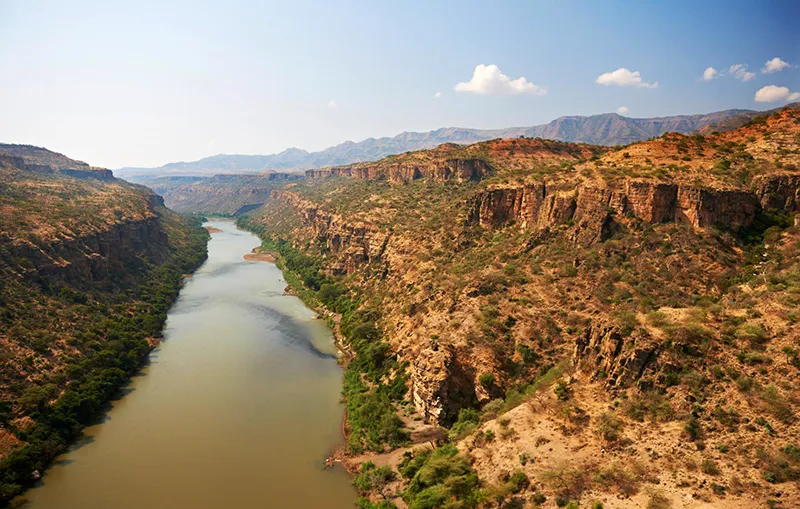The Nile is the longest river on the African continent. It is more than 6,000 km long. But not everywhere its waters flow as leisurely and quietly as we are used to seeing in postcards. In Sudan, near Khartoum, the Blue Nile accelerates and its waters turn into thundering waterfalls.
Africa’s Longest River
The Nile is, until recently, the longest river in the world. In 2013, scientists found that the Amazon is longer than the Nile by 140 km.
The poets of antiquity called Egypt “the gift of the Nile. Indeed, the fate of this country has always been closely connected with its main waterway. For many centuries, the annual floods of the Nile have determined the rhythm of Egyptian life. Every year at the same time, the water level of the Nile rose. The river would overflow and flood wide valleys, turning them into giant lakes. But in the early 19th century this natural cycle was disrupted by the massive construction of dams. Annual floods were replaced by man-controlled artificial irrigation systems. In 1971, the Aswan Dam was completed. It enabled the country to meet virtually all of its electricity needs, but in return faced unintended environmental consequences. It turned out that the dam trapped mineral-rich silt that had previously been distributed over crops by floods, and the emergence of the huge Aswan Reservoir in the middle of the desert caused climate change in the surrounding areas. But in spite of everything, the tourist boom off the Nile coast continues. Even Islamic fundamentalists, who try to prevent the development of tourism, the income from which is one of the most important items in the country’s budget, cannot prevent this.
Only the Nile River, Africa’s most important and most abundant river, prevents Sudan and Egypt from sharing the fate of other Saharan countries – Chad, Niger, and Mali – which are constantly plagued by severe droughts.
Egypt’s lifeline
It is impossible to overstate the importance to Egypt of the longest river on the African continent, stretching 6,671 km in length. To understand this, it is enough to refer to the history of Egyptian culture. People have long believed in the divine origin of the Nile. For centuries, ancient scholars argued about its origins. For example, Herodotus was sure that the Nile originated in the area between the islands of Siena and Elephantine. In fact, the Nile flows from Lake Victoria in the hot and humid region of Central Africa. For the last 3,000 km of its journey to the sea, the river flows through the desert, but it remains almost as full. On its journey from south to north, the Nile crosses three climatic zones (equatorial, tropical and desert). In the north of Egypt, the Nile passes Cairo and flows into the Mediterranean Sea. The river splits into several branches and rushes to the former sea bay south of Alexandria. Along the way, the Nile irrigates the “black earth,” the sedimentary masses that have formed over the centuries. For Egypt, as for Sudan, the Nile is a priceless treasure. On its banks, forming an evergreen oasis, one sees peasants and fishermen, traders and tourists. Yet the Nile carries more than just blessed moisture to Egyptians. In the past, disputes over the allocation of water have repeatedly caused conflicts between Egypt and Sudan, threatening to turn into a real war.
General Information
- The largest tributaries of the Nile: Blue Nile, Sobat, Atbara.
- Lakes: Albert, Edward, Nasser, Victoria.
- States through which the Nile flows: Uganda, Kenya and Tanzania (Lake Victoria), Ethiopia (Blue Nile), Sudan, Egypt.
- Length: 6,671 km (with Lake Victoria and the Kagera River).
- Average water flow: 2,600 m3/sec.
- Contiguous area: 2,870,000 km2.
- Nile Delta area: 22,000 km2.
Climate and weather
- Warm and humid in the south, hot and dry in the north (desert).
Attractions
- Luxor
- Aswan
- Nile Valley
- Cairo
- Alexandria
Fun Facts
- On the left bank of the Nile, opposite Luxor and Karnak, the Valley of the Kings, the City of the Temples and the City of the Dead spread out in a rocky landscape. These structures were built by order of the pharaohs of the Middle Empire, whose residence was the city of Teben (II millennium BC).
- Pheluges are typical sailing vessels very common on the Nile. They are long, narrow and very light boats.
- Ramses II, the “Great Sun of Egypt,” ruled the country in the early 13th century BC. It is believed that on the orders of this pharaoh were built famous figures of sphinxes in Luxor and Abu Simbel, which are silent witnesses to the former greatness of the country.
- Alexandria, Egypt’s most important seaport, lies in the western part of the Nile Delta. The city was founded in 331 B.C. by King Alexander of Greece and was considered the largest scientific center of its time.




